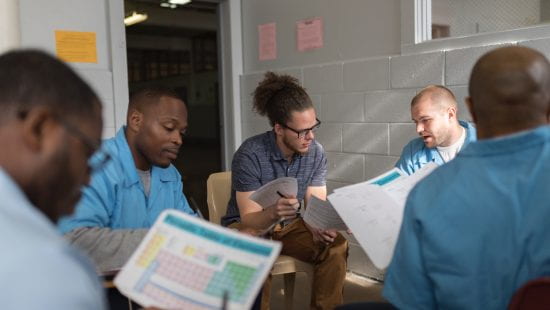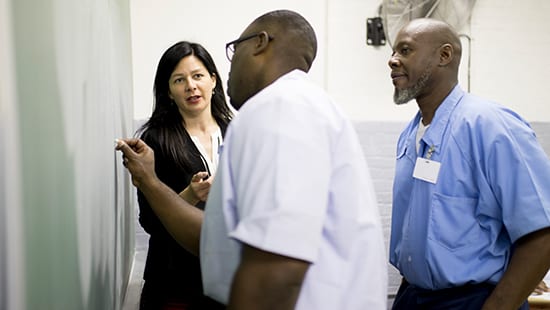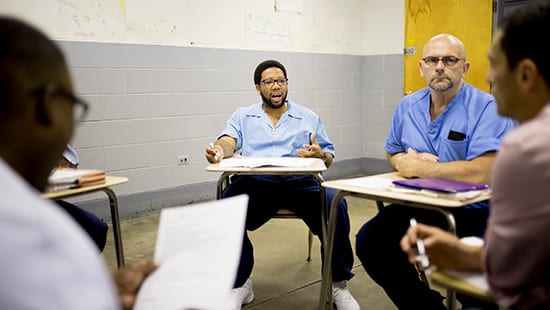Mass Incarceration in the U.S.
With more than 2.3 million people under the control of the American criminal justice system, the United States has more total prisoners than any other country in the world, and we have the world’s highest incarceration rate—one that is 4 to 8 times higher than those in other liberal democracies.
Not only have our prison and jail populations swelled to an unprecedented size over the past 40 years, but the conditions in which people are confined have grown increasingly harsh. Across the nation, prisoners are spending more time in solitary confinement, medical and mental health care are often seriously inadequate, and significant cuts have been made to vocational, recreational, and educational programming, even as prison sentences have become longer and more inflexible.
Moreover, incarceration “is not an equal opportunity punishment.” African Americans are incarcerated at more than 5 times the rate of whites, and while African Americans and Hispanics make up about 32% of the US population, they constitute 56% of the incarcerated population. Indeed, if African Americans and Hispanics were incarcerated at the same rate as whites, prison and jail populations would decline by almost 40%.
The Northwestern Prison Education Program (NPEP) aims to be a leader in responding to the crisis of mass incarceration through providing high-quality educational opportunities to incarcerated students in prisons in the state of Illinois.
Benefits of Prison Education

Recidivism
The Bureau of Justice Statistics studies have found high rates of recidivism among released prisoners. One study, which tracked 404,638 prisoners in 30 states after their release from prison, found that about 2/3 (67.8%) of released prisoners were rearrested within 3 years of release and more than 3/4 (76.6%) were rearrested within 5 years. More than half (56.7%) of these rearrests were in the first year after release. However, there is a 43% reduction in recidivism rates for those prisoners who participate in prison education programs. Indeed, the higher the degree, the lower the recidivism rate is: 14% for those who obtain an associate degree, 5.6% for those who obtain a bachelor’s degree, and 0% for those who obtain a master’s degree.
Employment Opportunities
There are increased and improved employment opportunities available for those formerly incarcerated people who engaged in prison education programs, and reentry is far smoother and more successful for those who took classes in prison, especially insofar as gainful employment is one of the defining features of successful reentry.


Cost Effective
Prison education is a highly cost-effective investment. A study by the Department of Policy Studies at the University of California at Los Angeles, for instance, found that “a $1 million investment in incarceration will prevent about 350 crimes, while that same investment in [prison] education will prevent more than 600 crimes. [Prison] education is almost twice as cost effective as incarceration.” Another study found that for every $1 invested in prison education, taxpayers save $4-$5 in re-incarceration costs during the first three years post-release.
“Inside” Benefits
Even for those who are serving lengthy—even natural life—sentences, prison education has profound and often life-changing benefits. There is a substantial reduction in violence and disciplinary infractions among those involved in prison education. A survey of an Indiana prison, for instance, showed that incarcerated people who were enrolled in college classes committed 75% fewer infractions than incarcerated people who were not enrolled. Prison education also breaks down racial and ethnic barriers that are often a cause of tension and violence in prisons, significantly improves relations between staff members and the incarcerated, and dramatically enhances the prisoners’ self-esteem.


Community and Intergenerational Benefits
The impact of education goes well beyond the walls of the prisons themselves, extending into the home communities of the incarcerated students. Studies show, for instance, that postsecondary prison education has many positive effects on the children of the incarcerated, offering a chance to break the intergenerational cycle of inequality and incarceration.
Racial Justice & Criminal Legal System Resources
This document, compiled by the Northwestern Prison Education Program (NPEP), is an extensive—but by no means exhaustive—guide for those who would like to learn more about and take action on racial justice and the criminal legal system.
